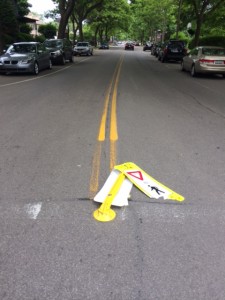 [Guest post by Pete Tonery.]
[Guest post by Pete Tonery.]
Rochester, like so many other cities, is engaged in a struggle to renew its inner hub. Through most of the 20th century, downtown Rochester was the unmatched center of the community. Kodak, medicine, retail, manufacturing were all headquartered in the city center. Then the forces of urban sprawl, a flight to the suburbs and a decreasing metro population drained the center of activity and commerce.
So now the City works to rebuild, reconfigure, and revitalize itself. Efforts are paying off. More young people travel to the city for entertainment and plenty are moving there to be close to the action. After years of loosing population the city is increasing its numbers, albeit at a modest 1% per year.
Efforts to revitalize cities are examined and shared all across the country. When waterfront improvements help grow one city, the movement is adopted by others. City governments are alert to what successful adaptations are and, as well as they can afford to, they adopt them.
So it is with bicycling. Municipalities know that developing good bike lanes, paths, and trails is a win-win for everybody. Bicycling is good for the environment, good for personal health, makes a city center quieter and more “livable,” and is distinctly friendlier than driving. Developing and encouraging bicycling as a principle means of transportation can be an important contributor to downtown revitalization.
But often planners only look to other cities’ successes, and fail to work directly with the important stakeholders — the bike riders themselves. That’s why a recent article in The Atlantic/Cities is both interesting and important. The story describes an in-depth survey of bike rider’s behaviors and decisions about riding in urban areas. Some of what the data reveals is common sense: riders don’t like hills, they will avoid having to turn on streets, and they want as little car traffic as possible. What makes the data stand out, however, is that the designers of the survey found a way to translate likes/dislikes into a formula that describes how strongly riders feel.
For example:
* Not surprisingly, riders like shorter distances to their destinations. What is interesting though is that, “ Every 1 percent increase in route distance reduced the chances that route was taken by 5 or 9 percent (non-commute and commute, respectively).”
* Riders like to avoid traffic lights. After all, a route free of them should be faster. There is a significant exception however: high-traffic corridors. Where the auto traffic is heavy traffic lights, “either decrease delay or increase safety (or both).” How important is this? The survey reports that, “For every mile of a non-commute trip, cyclists were willing to go 10 percent farther to avoid an unsignaled crossing at a busy intersection, and 16 percent farther to avoid a left turn at such intersections.”
* Maybe the most intriguing discovery was how much bicyclists, “preferred off-road bike paths or traffic-calming bikeways (“bike boulevards”) to traditional arterial bike lanes. Statistically, a bike path was so attractive that it was similar to, “reducing a route 26 or 16 percent (non-commute/commute) and a boulevard was like reducing it 18 or 11 percent.“
This data and these ideas are important for urban planners. If bike riding is a good, healthy and attractive aspect of city revitalization, then it ought to be developed in a way that relies heavily on the preferences of the users. Some of the ideas may actually save money on developing quality bike lanes, improve safety and — maybe — become a model for others.
The Atlantic: Cities:
What’s the Best Way to Figure Out What Bike Riders Really Want?






No Comment